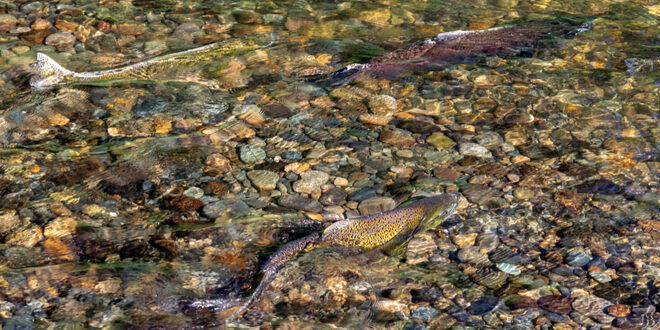State and federal biologists and engineers, in partnership with the Winnemem Wintu Tribe, have begun testing an experimental system in Shasta Reservoir that could help collect young salmon from the McCloud River in future years.
The Juvenile Salmonid Collection System, a pilot project six years in the making, is part of a long-term effort to help fish better survive California’s hotter, drier future and more extreme droughts. The collection system will float in the McCloud River arm of the reservoir and guide cold water toward a collection point, with this cold water flowing down from the Shasta-Trinity National Forest. The initial testing, which will run from September to mid-November, will not involve salmon but will use temperature and hydraulic measurements to assess the operation and performance of the collection system.
If successful, the system will be tested in future years with salmon to determine its efficacy and if it can be a critical part of winter-run salmon reintroduction. Biologists expect that juvenile salmon will follow the colder water to that collection point, where they can be retrieved and transported downstream around the dam to continue their migration to the ocean.
Recovery plans call for returning endangered Chinook salmon to their original spawning grounds in the cold McCloud River above Shasta Reservoir, where the fish may better survive drought and climate change. Juvenile salmon hatched in the river need to be collected as they migrate downstream before or just after they enter the reservoir that is home to warmer waters and predators.
Reintroduction efforts strive to reestablish endangered winter-run salmon in colder, high-elevation rivers where they once spawned before reservoirs blocked their migration. This would improve their resilience to a changing climate and could allow for more flexibility in managing water in the Sacramento River.
An important component of the project has been the commitment of state, federal, and regional authorities to Tribal engagement. Strategic efforts and planning have been enhanced with the support and commitment to developing a partnership with the Winnemem Wintu Tribe. The participation of the Winnemem Wintu Tribe brings unique perspectives and incorporates Tribal knowledge to the project.
“DWR is excited about the strong state, federal, and Tribal partnerships that are beginning to test the Juvenile Salmon Collection System,” said Karla Nemeth, DWR Director. “This team effort is critical in supporting salmon and their adaptation to our climate-driven hotter, drier future.”
The testing of the system will require intermittent restricted access for boats in the upper McCloud Arm of the reservoir, as the system spans the entire channel.
 California Water News Daily Your Source For Water News in California
California Water News Daily Your Source For Water News in California


